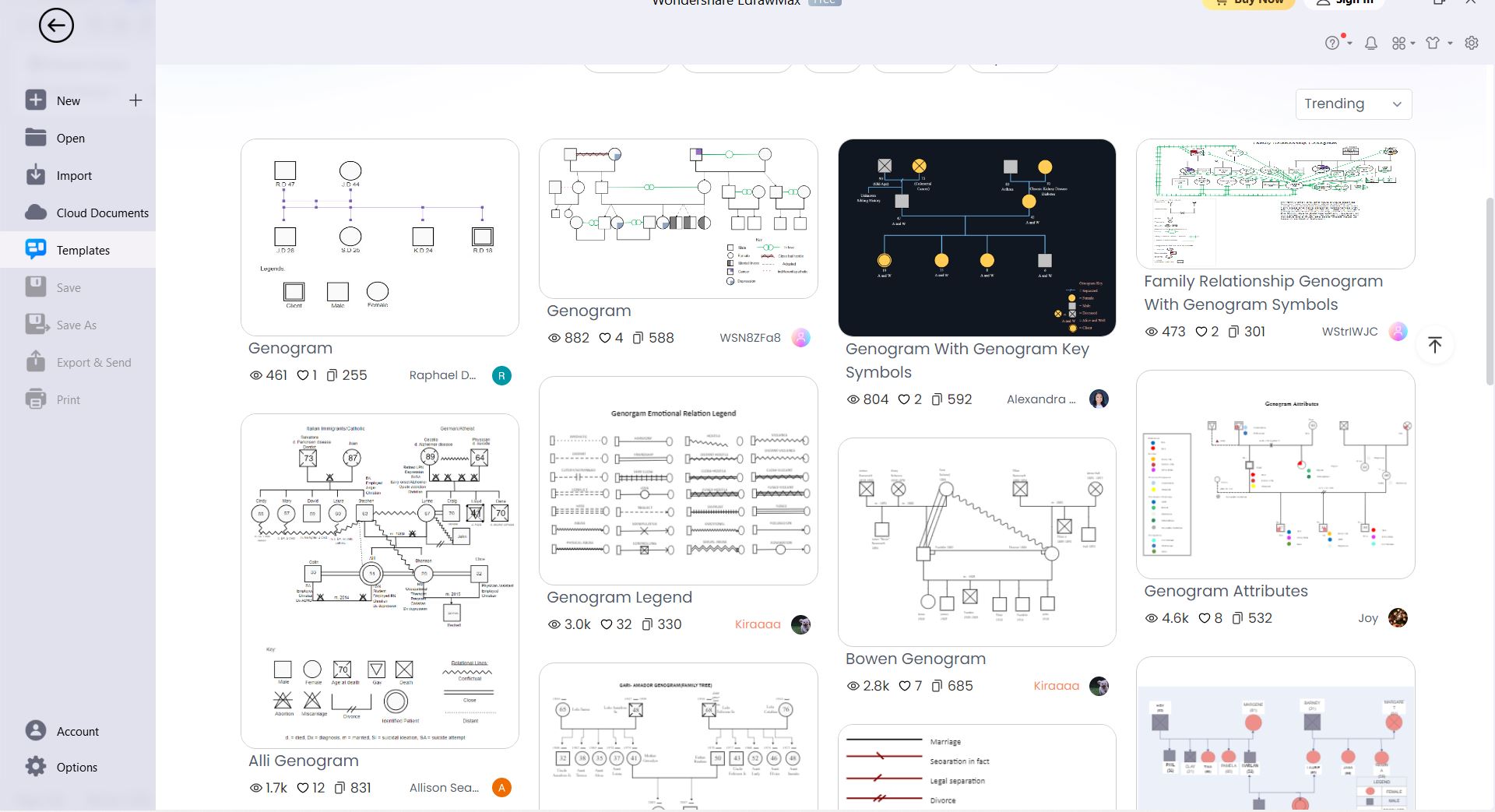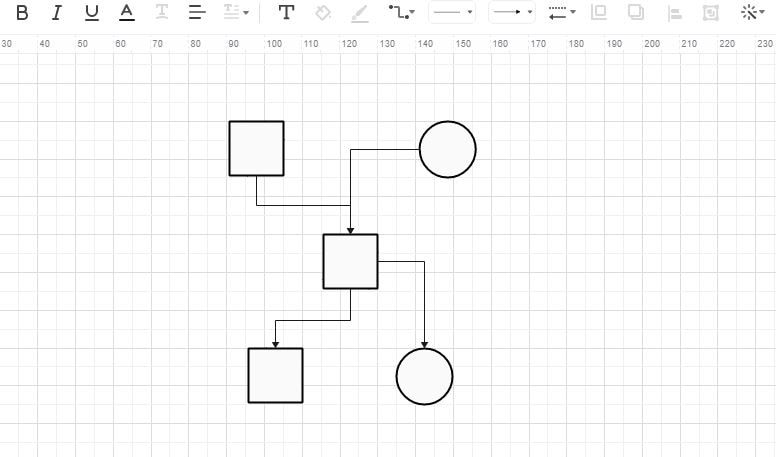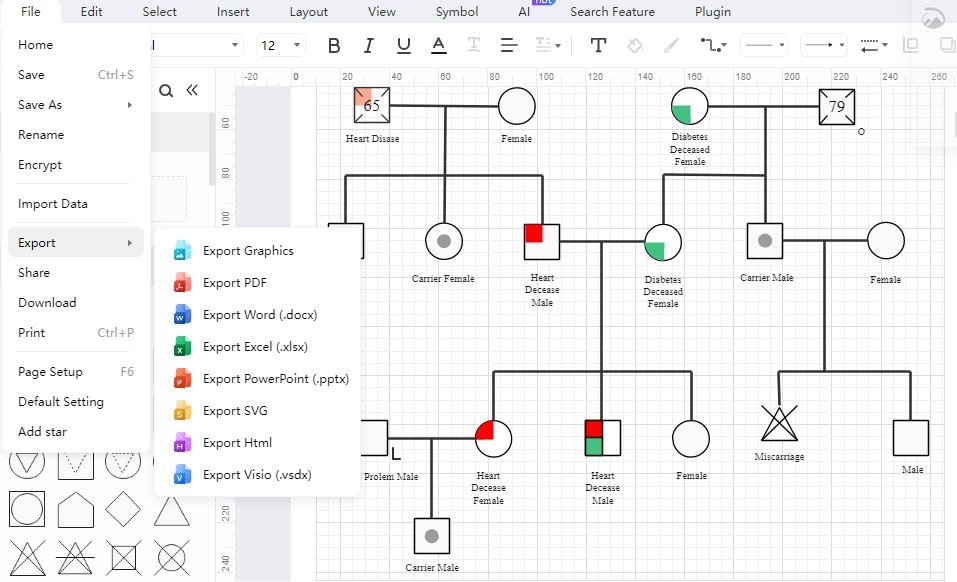When you embark on a journey to learn about genograms, you walk into the doors of fascinating exploration of family histories. A genogram is a family tree that provides comprehensive information about the family and each member. Genograms are crucial in understanding family dynamics, behaviors, and health histories. Genograms provide a visual map of relationships and help analyze recurring patterns, which can help therapists and medical professionals. In this article, we will take a look into what makes up a genogram, explore its examples, and learn how to create our genogram.

Some of the most common genogram symbols include squares for males, circles for females, and lines for relationships. Many other symbols represent different types of relationships, such as marriage or divorce. Similarly, genogram symbols are used to show medical conditions as well. This article will provide an in-depth analysis of the different types of genogram symbols and their meanings. It will shed light on the emotional relationship and medical symbols.
In this article
Part I. What is a Genogram?
A genogram is a picture that illustrates a person's family members, how they are related, and their medical history. A Genogram acts more than a family tree as it can provide history and information about a client or patient's problems. To illustrate these relations, genograms use symbols to represent gender, relations, or medical conditions. Some basic components of a genogram are names and birth dates, relations between every family member, medical history, and demographic information.
Generically, an older family member is at the top, with children positioned below parents and lines connecting children to parents. Married couple’s symbols are positioned next to each other, with a black line connecting them. Genograms can tell if someone is vulnerable to various diseases and help them impact an individual’s health. A person can explore their relationship patterns as well to see what might be affecting them.
Part II. The Origins and History of Genograms
In the 1970s, Murray Bowen introduced the concept of the genogram for the first time. Later, Genograms were frequently utilized in therapeutic settings after Monica McGoldrick and Randy Gerson published their work “Genograms: Assessment and Intervention” in 1985.
Genograms were used to identify repetitive patterns of behavior and recognize hereditary tendencies. Therapists used to explain family dynamics to clients as genograms have gained recognition in systemic therapies and behavior assessments. Genogram allows the spectator to discover genetic patterns and psychological components that emphasize relationships.
Part III. Benefits/Purposes of a Genogram
A genogram is a picture of your family tree that shows more than just who is related to whom. It can help us understand complex family dynamics and identify patterns across generations. Therapists and individuals can use genograms to learn about inherited traits, such as health conditions or behaviors.
They can also be used to discuss family history in therapy or counseling. Genograms can help people understand their families better. It also helps us see how family dynamics mold a person into who they are.
Part IV. Three Examples of Genograms
EdrawMax is a flexible diagramming tool that is simple to use and has a wide range of applications. Due to its many features, EdrawMax is a terrific choice for individuals and teams. Here are three examples of typical types of genograms from the EdrawMax mind-map gallery:
1. Family Generation Genogram
The Family Generation Genogram template is an effective visual aid for analyzing complex family dynamics. By mapping out numerous generations, it can reveal patterns and influences of the members. The Family Generation Genogram template has several parts. The pattern normally starts at the top with the eldest generation and proceeds downward through succeeding generations. This hierarchical layout aids in visualizing the relationships between family members.
The Family Generation Genogram template uses symbols such as circles and squares to represent family members, with lines representing marriages. Relationships and connections are portrayed with various lines and arrows to convey the kind and strength of the relationship.
The Family Generation Genogram template is used in a variety of industries.
- Medical and genetic research: Identifying inherited illness patterns and risk factors.
- Social Work and Community Development: Analyzing social networks and migration trends to guide interventions for community well-being.
- Historical and Genealogical Research: Uncovering family histories and societal changes across time, as well as recording influences on previous generations.
2. Medical Genogram
The Medical Genogram, which evolved from the Family Generation Genogram, is a powerful tool in healthcare. It is designed for the medical field and visually shows complex family medical histories and genetic linkages. In real-world circumstances, it can provide crucial insights for medical research, diagnosis, and therapy. The Medical Genogram template, which looks like a family tree, displays each member individually by emphasizing their position in the family hierarchy. You can convey a spectrum of medical information using symbols, including:
- Heart Conditions
- Mental Health Disorders
- Swift Pattern Recognition
Relationships are represented by lines and arrows, with colors and patterns used to differentiate between different sorts of connections. This genogram also incorporates critical facts such as birthdates, causes of death, and medical treatments, which can give healthcare practitioners with a full view.
Medical Genograms are used in various fields, such as:
- Medical Research: Medical Genogram aids researchers in deciphering genetic markers, hereditary patterns, and potential intervention points for specific medical conditions.
- Diagnosis and Treatment: Healthcare professionals leverage the Medical Genogram to assess patients' disease risks, enabling informed decisions on diagnosis based on family medical histories.
- Genetic Counselling: Medical Genogram helps genetic counselors guide individuals and families in understanding genetic risks and informing decisions about family planning and genetic testing.
3. Career Genogram
The Career Genogram is a dynamic lens that reveals the deep interplay between a person's professional journey and the familial fabric that determines it. It shows trends, attitudes, and opportunities that integrally impact and lead one's own career trajectory by documenting the different jobs of family members over generations.
The work Genogram template employs symbols, lines, and supplementary information to illustrate various aspects of an individual's work and the professional history of their family. Using specialized symbols, it graphically portrays crucial professional characteristics such as education, achievements, and transitions. The tapestry is enhanced with additional layers of detail, like employment dates, promotions, and milestones. This action enables a more in-depth examination of familial professional histories. This template serves as a compass, driving pattern research and influencing the geography of family careers.
Some major applications of Career Genograms are:
- Career Counselling: Counselors use the Career Genogram to provide tailored guidance to clients, utilizing familial career patterns to identify viable courses and growth opportunities.
- Human Resources: HR professionals use the Career Genogram to get insight into employee dynamics, aid in team building, identify leadership, and establish a supportive work environment.
- Succession Planning: The Career Genogram is useful in identifying potential successors, assessing suitability, and ensuring a smooth transition of leadership in family enterprises.
- Personal Development: Individuals create Career Genograms for self-reflection to obtain insights into their professional journey, strengths, problems, and growth opportunities to make educated career decisions and set goals.
Part V. How to Make a Genogram
Step1Setting up the Genogram Project
Launch the EdrawMax application or website. Create a new project and define the purpose of your genogram, like a medical or a family tree. Then, choose a suitable layout to accommodate family structures and relationships.

Step2Adding Family Members and Relationships
Now, add the names of family members to your genogram. Use symbols like circles, squares, and lines to represent males, females, and connections. Arrange the symbols to reflect the family hierarchy.

Step3Customizing Symbols and Colors
In EdrawMax, you can modify your genogram by adding other symbols. When you click the "Symbol" button in the toolbar, you can select the correct symbol from the list of various symbols. Moreover, you can add or remove symbols as you want. You can assign colors to signify medical conditions, emotional dynamics, or other relevant information.

Step4Adding Additional Information and Annotations
Include the date of birth, death, employment, or any family data in the shape of a genogram by double-clicking on them. Annotations aid in setting the scene by highlighting significant events that have an impact on family dynamics.

Step5Exporting and Sharing the Genogram
Once your genogram is complete, you can export it in different file formats. Export your genogram in formats such as image files or PDFs. EdrawMax's export features make it easy to share your genogram for collaborative discussions.

Conclusion
In conclusion, research into genograms gives details about the dynamics and histories of families. These vivid representations offer a unique viewpoint on social dynamics, medical histories, and emotional processes. The intricacies of families are understandable using genograms. By examining its origins, it highlights how crucial this powerful tool is for family rituals, therapy, and introspection. Genograms can easily distinguish the intricate web of human forebears.
[没有发现file]




 below.
below.  below.
below.


